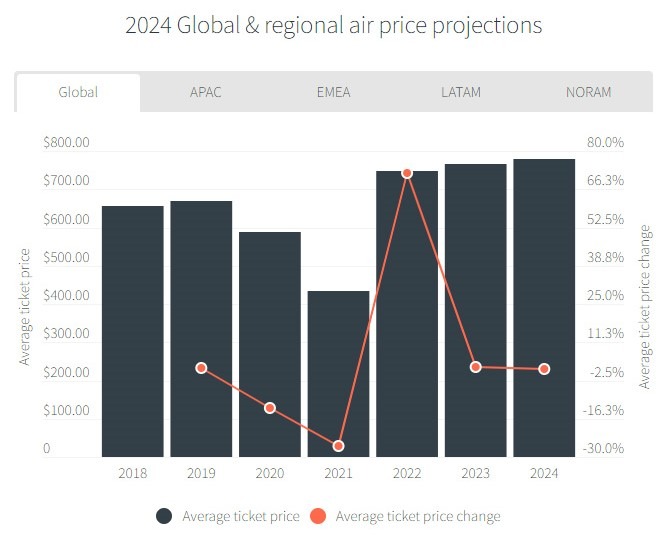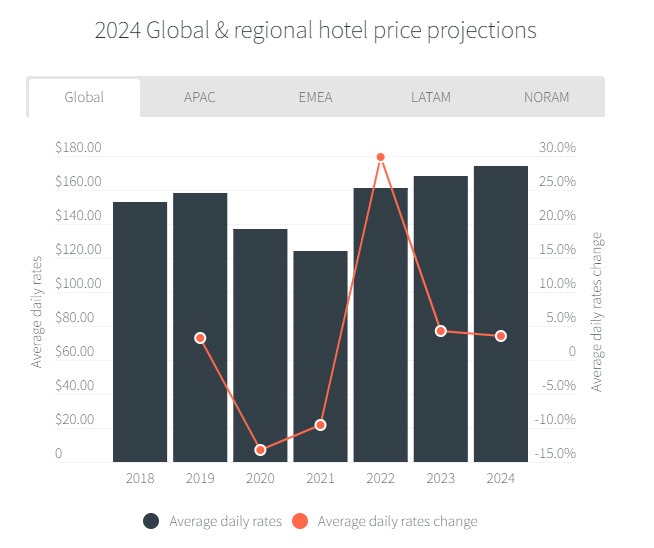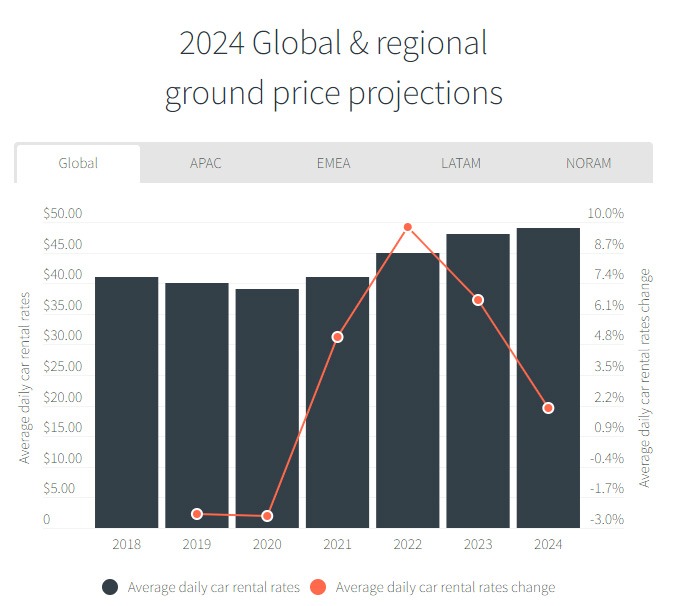Plus strategies for managing increased business travel costs in 2024
Business travel and event cost are not increasing as steeply as they were in 2022, but they’re still going up, according to 2024 Business Travel Forecast, a new study by CWT and Global Business Travel Association (GBTA).
The increases in price forecasted in 2022 by CWT and GBTA were far outpaced by the actual numbers across all sectors. In 2022, air travel saw a 72.2% increase (forecast: 48.5), hotels saw a 29.8% increase (forecast: 18.5%), ground transportation increased by 9.8% (forecast: 7.3%), and meetings and events, measured by the average cost per attendee per day, increased by 58.1% (forecast: 25%).
Looking ahead, while prices remain at elevated prices, the increases are forecasted not to be nearly as steep as prior years. CWT CEO Patrick Andersen says, “We could now be looking at the true new cost of travel.”
Air Travel

Despite the chaos airlines have seen over recent years, passengers are not staying away. According to Internal Air Transport Association, airlines are expected to carry 4.35 billion passengers in 2023, nearly reaching 2019 numbers, a year that saw 4.54 billion traveling across the globe.
Read More: Helpful Technology for the Organized Traveler
This high volume of passengers, thought to be mostly from pent-up demand from leisure travelers, is also happening in the face of rising air prices. In 2022, the average global ticket price rose to $749, a rise from its 2019 level of $670, which the study has attributed to the continuing shortage of pilots, a dearth that is expected to grow to 34,000 by 2025, and supply chain issues affecting manufacturing, maintenance, repair and overhaul of planes.
Accommodations

The average global daily room rate rose to $161 in 2022, more than $14 higher than predicted. According to the study, cities such as Miami, London and Singapore reported their highest average daily room rates on record that year.
The study states that pricing power and demand are no longer coupled, as rates are being driven by forces other than demand, namely inflation, labor shortages and higher energy costs.
“In the past, pricing power has followed demand, where those rooms with the strongest occupancy growth also posted the highest ADR gains,” the study reads. “This trend has not happened post-pandemic. It is likely that non-demand related costs—including inflation, labor shortages and energy costs—have been the primary force behind this pricing peak.”
Ground Transportation

Car rental prices around the globe rose to $45 a day in 2022. In 2023, prices are projected to rise by 6.7%, to an average of $48. In 2024, the rental costs are estimated to rise one more dollar to a daily rate of $49.
Read More: Navigating the Bus Driver Shortage
In 2022, prices soared for a number of reasons. One of which is due to the shortage of semiconductors, now used in many modern cars. Although the production of vehicles slowed down, demand didn’t, resulting in the steep hike seen in 2022. The study predicts if demand outpaces supply again, you can expect prices to increase rapidly again.
Meetings and Events
Costs across different sectors of the events world increased. In 2022, the average cost per attendee rose to $160, and is expected to rise to $169 in 2023, and face a slightly shallower increase in 2024, at $174. ADR for group bookings follow the same trend. The pricing in 2022 was at $297 and is expected to increase through 2023 into 2024, at $310 and $321, respectively.
“Right now, buyers cannot have preconceived ideas about how far their budget will go,” the study reads. “A perfect storm of constricted availability, higher prices and important considerations around ESG, and DE&I make a centralized strategy the most effective way to plan and manage meetings activity.”
Approaching Planning Differently
With all this, CWT presents buying strategies heading into 2024 that may help planners prepare for increased business travel prices.
- Shift to long-term planning. Planning ahead allows organizers to explore more options at a better price, while enjoying better leverage.
- Consolidate and compromise. Aggregate travel spend to increase the value of regular contract proposals. Compromising on when staff travels can also be beneficial.
- Focus on ROI. Prioritize business trips that offer the greatest return and enable employees to be at their most productive when traveling.
- Use price optimization tools. Tracking spending can prevent overpaying.
- Use loyalty rewards. Suppliers want to reward loyalty, even when their leverage is down. Along with this, planners have a better chance of controlling costs and getting discounts if they focus on a small number of destinations and routes.
- Experiment. Think outside of the box in terms of destinations and type of events conducted and test new travel tech and strategies.




